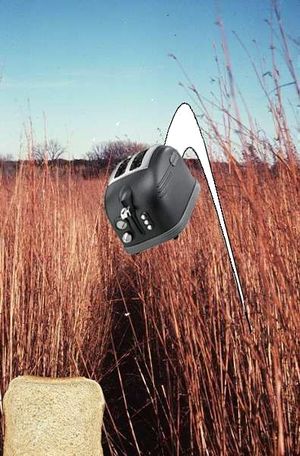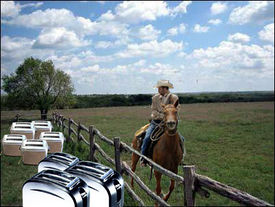User:Necropaxx/Toaster
| Toaster | |
|---|---|
 | |
| Scientific classification | |
| Kingdom | Animalia |
| Phylum | Arthropoda |
| Class | Crustacea |
| Order | Aluminata |
| Family | Appliancidae |
| Genus | Toasterus |
| Species | T. blanco |
| Binomial name | |
| Toasterus blanco | |
| Specifications | |
| Primary armament | suffocation |
| Secondary armament | poison plugs |
| Power supply | Any outlet will do. |
| Health | ??? |
| Mana | Profit! |
| Strength | More than you, wimp. |
| Intelligence | More than a fridge, less than a microwave. |
| Weight | Ranges from 1 pound to 5 lbs. |
| Length | From 1 foot to 1.5 feet. |
| Special attack | Inflammation |
| Conservation status | |
| Domesticated | |
“Gentlemen, I have seen the future. And the future... is toasters.”
– George Washington Carver on toasters
A toaster is a small land crustacean. It is generally shiny and box-like, although this can vary from species to species. The toaster has an aluminum exoskeleton with up to four slots that make up the mouth; protruding from the outer shell is a lever that is pushed down to consume prey. Also present is a dial determining how much of the prey is to be consumed, or in layspeak, "toasted." The toaster's natural habitat ranges from deciduous to evergreen forests. A ferocious predator, toasters have nevertheless been domesticated extensively by humans of nearly all walks of life.[1]
Toasters in Nature[edit | edit source]
On the evolutional tree, toasters are very closely related to other appliances, especially microwaves. Toaster ovens are not as close to "true" toasters as you might think, but nonetheless share much of the same DNA. Also related to toasters are appliances such as refrigerators and stoves. Toasters are ferocious predators, and are hunted only by the occasional dire wolf, and of course, man. The prey of a toaster may include but is not limited to sliced bread, loafed bread, bagels, waffles, Pop-Tarts, pancakes, English muffins[2], and occasionally paper money.
Eating Habits[edit | edit source]
In the early 19th century, toasters were still a mystery to mankind. In 1823, George Washington Carver set out on an expedition to the California redwoods to study toasters. Over a period of ten years, Carver studied the eating habits of toasters.
When a toaster first spots prey, it will immediately drop into a crouch and stalk the unfortunate bread slice until it stops to drink or eat. The toaster pounces at once, crushing the slice. The toaster will use its poisonous plug at the end of its cord, or tail, to stab the prey into submission. Once the bread slice has stopped thrashing, the toaster will use its cord to drop it into one of its slots. Then something occurrs that continues to befuddle scientists today. As the toaster consumes its prey, it will become excited and produce an electric reaction, called "heat." This amazing reaction is called toasting.
Courtship and Mating[edit | edit source]
There comes a time in every toaster's life when it will feel the need to reproduce, to start a family. First he will seek out a prospective mate, which can usually be found at singles bars. If a suitable mate can be found and if the male is not rejected at first sight[3], he will begin an elaborate coutship dance. This dance consists of seven parts, five of which are too vulgar and/or disturbing to be inncluded in this article. Firstly, the male will capture a piece of prey. Uncommon preys, such as waffles or bagels, are valued more to females than common preys like bread. The prey that has been captured must be alive. If the male toaster was to toast the prey before presenting it to his potential mate, not only would he be rejected on sight, but also devoured alive.[citation needed] Once the male has sufficiently wooed his mate, they will retire to a secluded area to, ahem, procreate.
Toasters and Man[edit | edit source]
Man and toasters have had a long and illustrious history, often near-symbiotic creatures, each depending on each other for survival. The first ever domestication of a toaster occurred in Ancient Rome, where on a mosaic in Vesuvius there is shown a man and his pet toaster. As the industrial revolution brought about the destruction of many habitats of different animals, the toaster habitat one of them. Toasters dwindled in the wild, until there were no more left. However, toasters were saved from extinction by an Englishman named L. Ron Hubbard, who preferred toast in the morning with the butter side down. An enterprising man, L. Ron saw the potential in the toaster as livestock. He quickly set up a toaster ranching empire. This not only saved toasters from utter doom, but humans of all walks of life could now own a loving pet.[4] Toaster ranches were a lucrative way to make money, and in the frontiers of America from 1800 to 1850 self-styled toasterboys tamed the ole west. Now, toasters are raised in Texas alone, which make its chief export. Movie directors saw the glory in that old way of life, and "toaster westerns" make up a principal part of American culture.

